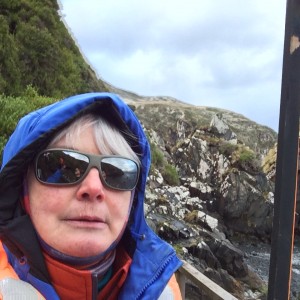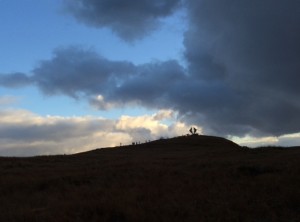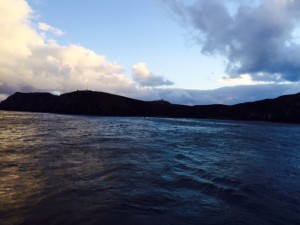October 30, 2014
We are lined up in our orange life jackets, wearing layers of jackets and fleeces, caps and hoods over our heads, waterproof mittens and boots on our hands and feet. The line of 130 people extends from Deck 4 down to the stern of Deck 2. I am standing on Deck 3. Black zodiac boats with their drivers at the tillers bob on the dark waves. The sun which had been shining cheerfully now has disappeared behind thick dark clouds. It is past six o’clock. No one is talking much. We are waiting for the captain of the expedition ship Via Australis to decide whether or not we can board the zodiacs and land on infamous Cape Horn. If the waves are too high and the wind too strong, we will not go.
Cape Horn is a small island, not a cape, and is the southernmost point of South America. To its south lies Drake’s Passage and Antarctica. Cape Horn is one of the stormiest and most dangerous passages in the world. Winds blow cold and constant between 35 – 125 knots. Waves typically are between 80 to 120 feet rising out of freezing cold water and the likelihood of survival once overboard is minimal. Before the Panama Canal was dug, sailing ships rounded the Horn to reach the Pacific Ocean and California. Over ten thousand people have perished in these seas from shipwrecks.
Now we tourists are hoping to land on this treeless rock of an island and visit the memorial to the lost sailors. Though I have not heard of any tourists drowning, there have been many accidents—broken arms, broken legs, broken fingers and ankles. On the last landing our trip leader made, a tourist from another group broke her leg very badly, a compound fracture. My own accident on a bridge in the Amazon jungle in 2011 is vivid in my memory.
As we wait, I feel more and more apprehensive. The dark clouds and the shower of rain add to my worries. I can see Cape Horn quite clearly. I don’t need to land on it. The voice of caution in my head says, “Turn around. Get out of the line. Stay on the ship.” But I wait, hoping that the captain will take the decision out of my hands, and tell everyone not to disembark.
Finally there is a shouted command, and the line begins to move. Around me are my fellow travelers with whom I have been adventuring for over a week. Their presence gives me some courage. Also, we have boarded and disembarked from the zodiacs several times the past few days, though never with so difficult a landing, and I know the crew are strong and take good care of us. I will trust my life to them.
To my right is the board holding the cabin numbers of the passengers. I hesitate for a moment, then unsnap the cabin tag from my life vest, and hang the tag from the hook below my cabin number: 417. It will await my return.
The line stops moving abruptly. The zodiacs have backed away from the ship again, and the ships’ engines are roaring; the captain is moving the ship to better position the stern for the oncoming battering waves. We wait, and then the line begins to move again. The metal steps are slippery with rain, and I walk down carefully, leading left foot, left foot, like a child. My knees are bone on bone, with bone spurs, and this trip has been very hard on them.
The zodiac is lashed to the ship with a rope, and a crew member extends his arm to me. I grasp his forearm with my right hand, and step onto the rubber rim of the zodiac, then down into the boat, sit down on the rim and slide to the stern, up against one of my shipmates. Loaded with twelve passengers, we back away from the ship.
I grab the rope that runs around the top of the zodiac rim with my right hand and hang on tightly. The waves are rough and the driver zigzags the boat to keep from being overturned. To my left one of the German women is bent all the way over into the zodiac. I had heard her talking to her husband earlier, obviously pleading not to go. He replied that it was the highlight of the trip. I could make that much out, even though I don’t speak German. She is plainly terrified. So am I.
Some of the German tourists start singing loudly. The zodiac driver is laughing. I am saying a four letter word over and over, under my breath. As we reach the cove of the island, the waves are not as bad, but the water still is very rough. Two of the crew are clad in wetsuits and standing in the water, up to their waists, to help secure the zodiac and hold it next to the landing site.
With the help of the crew, the passengers disembark. One by one we slide to the bow of the zodiac, as far up as we can, swing both legs to the left over the side, and step onto the water- swept ramp. I have short legs but I manage to disembark without getting my feet very wet. The ramp leads to the wooden stairway that climbs the side of the cliff.
 I start the long painful climb, being careful because the wooden stairs are slippery with rain, and in some places rotten. I am thankful for the railing which I grab to pull myself up each step. On the lower part of the stairs there are landings where I can stop and rest and take some photographs. I lose count of the number of stairs.
I start the long painful climb, being careful because the wooden stairs are slippery with rain, and in some places rotten. I am thankful for the railing which I grab to pull myself up each step. On the lower part of the stairs there are landings where I can stop and rest and take some photographs. I lose count of the number of stairs.
Finally I am at the top of the cliff. From here to the right, a wooden board walk and steps leads to the sailors’ memorial erected in 1992—a round metal disc with the center perforated by a stylized albatross. To the left the walk leads to a chapel and the lighthouse, where a member of the Chilean navy and his family currently are stationed. When I step out of the shelter at the top of the stairs, I am blasted by the wind. The wind was bad on the steppes of Patagonia, but it is much worse here. It is difficult to stand still and take a photograph.
 The passengers are bent over and staggering along the walkway, where there are no railings. They look like figures in the final scene of Bergman’s movie, The Seventh Seal. I debate whether or not to go all the way to the memorial and finally decide against it. I am on Cape Horn, I do not need to go any further, and I need to save my strength to descend the steps safely.
The passengers are bent over and staggering along the walkway, where there are no railings. They look like figures in the final scene of Bergman’s movie, The Seventh Seal. I debate whether or not to go all the way to the memorial and finally decide against it. I am on Cape Horn, I do not need to go any further, and I need to save my strength to descend the steps safely.
Already some of the passengers from the first few boats are returning to go down the cliff, and after taking a few more photographs, I turn and start down the stairs. A few feet below me, one of my fellow travelers slips on the wet stairs and slides down a few feet. She says she is not hurt. I hold the railing a bit tighter. The sun has partially emerged from the clouds; it is much lower on the horizon. Our hour on the island is almost up.
I get into a waiting zodiac, swinging both legs into the boat. The waves seem to be bigger now, and I lean into the boat, as the German woman did. Now I am repeating softly my mantra from The Hobbit: there and back again, there and back again. The zodiac bobs and leaps toward the ship.
The rope to secure the boat is lying by my foot, and I lean over to pick it up and throw it toward the bow, but my body is blocking the motorman’s view of the ship’s ladder. He shouts at me to sit up, which I quickly do. He tries several times to get the zodiac close enough to the ship for a crewman to climb down to help us. Finally one of the crew climbs into the boat.
When it is my turn to get out, I slip and fall, my right knee landing heavily on the black rim of the boat. I can feel the blood welling to the surface, but I clamber upright and take the extended arm of the crewman, grasping the ladder of the ship with my other hand, and climb up to safety.
That night is our last on the Via Australis. We toast the success of the expedition with champagne. The boat crews are ecstatic and beaming; they achieved a rough landing with no one injured. And me? I am ecstatic, too. I made it, there and back again.
Poem at the Sailors’ Memorial
I, the albatross that awaits for you at the end of the world…
I, the forgotten soul of the sailors lost that crossed Cape Horn from all the seas of the world.

But die they did not in the fierce waves,
for today towards eternity in my wings they soar
in the last crevice of the Antarctic winds
Sara Vial Dec – 1992


